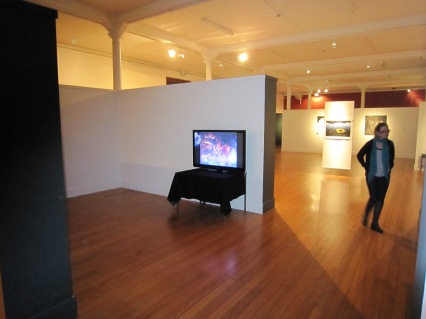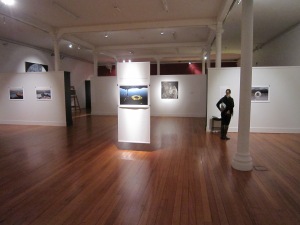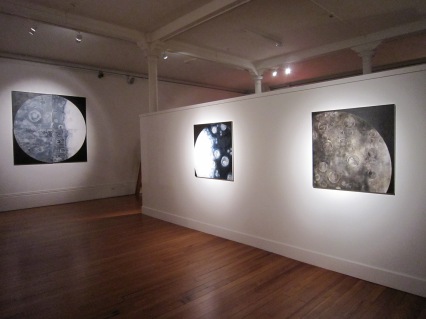Putting Yourself in Space
A Pilot Study Investigating the Effect of Viewing Space Images
Collaborators: Jenny Rock [Science Communication] and Jeff and Lisa Smith [College of Education]
University of Otago researchers Jeff and Lisa Smith have suggested that people feel better about themselves on a personal, interpersonal, and societal level while they are visiting art museums. They have conducted research using a scale developed to measure citizenship, and found that, in the middle of a museum visit, people respond more favourably to the measure than others in the beginning or at the end of their visit. Their research also shows that this feeling is not generally based on viewing a particular work of art, rather, it is the cumulative effect of selective viewing over a number of works. They liken this to the pleasure of doing a crossword: there would be no reward if you got every clue instantly. The pleasure comes from it being a good mix of those you get and those you don’t, and from the effort made in doing so. How does this happen? They think it is related to the idea of “flow.” Flow is a concept developed by psychologist Mihalyi Csikszentmihalyi which argues that flow, or optimal experience, occurs when we become so engaged in what we are doing that we become completely engrossed, and lose track of time and space. Flow has been related to activities as disparate as rock climbing, teaching, and playing professional gridiron football. The Smiths believe a type of flow operates within the art museum setting, causing individuals to reflect on their values, their interactions with others, and how they view society and the earth itself.

Our hypotheses:
- ‘Flow’ can be achieved when viewing (trying to interpret) something vast and alienating like deep space imagery. This is because that imagery is so enormous and alien it challenges us to conceive of our place in it.
- It takes time for the state of ‘Flow’ to be achieved. It is not instantaneous upon viewing the image and requires moving from a state of perceiving (questioning ‘what am I seeing?’) to a state of relational conceiving (questioning ‘how do I fit into this?’; i.e. relational seeing).
- The act of relational seeing or conceiving of yourself in the universe, can be likened to introducing a narrative into the cognitive process. Questioning, ‘What do I make of this relative to myself’ will involve invoking a personal narrative. For example: what would it really look like if I were there, would it feel like, and what would happen to me if I were there? But more intensely, what does my life matter compared with all this? How was I generated from all this? Questions of where did I come from and where am I going to are parts of an intensely personal narrative that may allow us to conceive of the magnitude of scale of space- conceiving of the dimensions allow better engagement with the science. It is the same as interacting with fossils to conceive of the magnitude of time: these are vital for engaging effectively with the science of evolution.
THIS EXHIBITION TAKES US FROM SPACE TO EARTH AND BACK AGAIN. (1812 Gallery, Otago Museum, Nov 2011; curated by Jenny Rock)

From AESTHETICS OF ASTRONOMY,
MOVE TO NZ earth scenes martin hill – bare bones of terra firma- rock and reed, water and berry, then back out to space with NICOLA GIBBONS FAR AWAY SO CLOSE.
SPACE…. How we grasp this big stuff- (or little stuff to- how do we conceive of the universe of complexity inside our living bodies) – how do we conceive of let alone engage with most of what astronomy is showing us?
Whenever you get to the point of thinking about the nitty gritty of conceptualising really tough topics in science I turn to my second passion besides biology and that is art. I am deeply convinced that art- the tools of the humanities generally whether fictional narrative or poem or visual image or even music can convey- can connect us with understanding science in the most powerful way.– And I am not just talking packaging…. making the information or lesson pretty- I am talking about the important components of emotion, holistic or integrative perception or thought, and the intense power of visual narrative in our essential cognitive processes.– In other words- we are deep programmed to think in visual or more appropriately sensorial ways. – Our basic powers of cognition rely on aesthetics and tools we normally associate with the humanities – which in fact we find are not exclusive to the humanities- they span science and art.

Methods:
1877 Gallery Exhibition space; 6-12 digitally displayed NASA images in darkened central gallery space; ScienceTeller festival (and general public) participants.Test environment 1:
Test 1: ‘cross-over’ survey (drawn from previously tested instrument for measuring personal & societal feeling) conducted on entry and exit (1 page each) …as well as measure of perceived learning (science knowledge content?)
Test 2: Issue voice recorders to capture state of mind of each participant whilst viewing images. Recording will be started at the commencement of viewing each (identified) image: this provides a time reference to track the “progression” of thoughts/feelings during the act of perceiving/conceiving. Verbal description of process of perceiving/conceiving can be complete sentences, phrases or individual words. This test requires transcription of responses against a time index, and then ranking of response into categories from generally descriptive to those linked with personal narrative (e.g. the viewer’s place in the universe).
Test environment 2:
Jay O’ Callahan’s performance of “Forged in the Stars” (two performances). (Also (?) IMAX film Hubble viewing on Sat evening.)
This extends our pilot study to assess (as per methods in Test 1 above) the positive effect of listening to a verbal narrative about people and space.
Data analysis of thoughts over time will address the following questions:
– Does viewing space images have an influence on individual/societal positive feelings?
– Does this correlate with the introduction of a personal narrative whilst viewing 1 or more images?
If we equate the above with a moment of ‘Flow’ having been achieved during viewing, we can then ask:
– Is there a linear relationship between duration of viewing and achieving ‘Flow’?
– Does this lead to a higher degree of positive individual/societal positive feelings?
– Does it affect perceived learning?
– Correlation of above with other ‘characteristics’ of the participants (e.g. age)?
Wordle representations can be used to graphically depict text responses at various time points.

You must be logged in to post a comment.